Frequently asked Climb questions
• What environmental ethics does SENE practice?
• When is the best time of year to climb Kilimanjaro?
• What is SENE Kilimanjaro route advice?
• What equipment and clothing will I need for the climb?
• What health and safety precautions does SENE takes?
• What is your tip recommendation?
Find below other important information for our climbs. Click on a box to toggle open the content.
SENE on Kilimanjaro
For safety reasons and team support we always have climbers hike with at least one guide and with other team members.
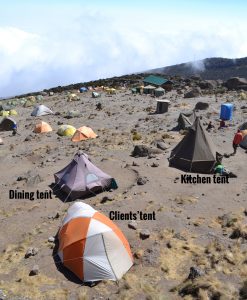 We use exclusively Mountain Hardwear Trango 4-person tents (shared by two people only) and Trango 3-person tents for singles. Our dining tents are either large Cabela’s Outback Lodge tents, Mountain Hardwear’s Space Station dome tent, or a specially-designed locally-made mess tent made from lightweight waterproof canvas. Collapsible lightweight dining tables and camp chairs are set up inside the dining tents.
We use exclusively Mountain Hardwear Trango 4-person tents (shared by two people only) and Trango 3-person tents for singles. Our dining tents are either large Cabela’s Outback Lodge tents, Mountain Hardwear’s Space Station dome tent, or a specially-designed locally-made mess tent made from lightweight waterproof canvas. Collapsible lightweight dining tables and camp chairs are set up inside the dining tents.
sleeping bags (0 degrees Fahrenheit)- $50
sleeping bags (-40 degrees Fahrenheit)- $100
sleeping pads- $10 each
trekking poles $10 for a pair
They need to be reserved and paid in advance.
We advise you bring the bare minimum of electronic equipment and charge items only when absolutely necessary as solar-generated power is at a premium on the (often cloudy) mountain. Enjoy as much as possible the beauty and silence around you, storing the memory of that in your mind to share in person later, rather than immediate electronic transmittal.
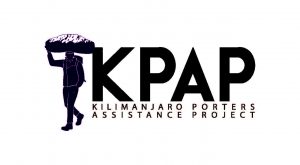 with the mission to improve the working conditions of porters on Kilimanjaro. Please also see our SENE page about KPAP.
with the mission to improve the working conditions of porters on Kilimanjaro. Please also see our SENE page about KPAP.
health and Safety
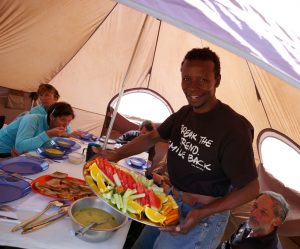 Meals on all SENE climbs are delicious and provide the nourishment needed for each day’s challenge. Menus are designed by Simon using his training as a cook and high performance nutrition expertise from more than 25 years as an endurance athlete and mountain climber. Our mountain chefs, trained in continental cuisine and food preparation hygiene, prepare all meals from scratch. Fresh food is re-supplied every three days and all meat and produce are maintained fresh in cooler boxes. We can cater to most dietary needs such as vegetarian, vegan, gluten-free, etc. Please indicate any dietary restrictions on your registration.
Meals on all SENE climbs are delicious and provide the nourishment needed for each day’s challenge. Menus are designed by Simon using his training as a cook and high performance nutrition expertise from more than 25 years as an endurance athlete and mountain climber. Our mountain chefs, trained in continental cuisine and food preparation hygiene, prepare all meals from scratch. Fresh food is re-supplied every three days and all meat and produce are maintained fresh in cooler boxes. We can cater to most dietary needs such as vegetarian, vegan, gluten-free, etc. Please indicate any dietary restrictions on your registration.
Breakfasts may include oatmeal, scrambled eggs, French toast, bacon, toast, fresh local fruit (pineapple, oranges, bananas, mango, papaya, apples, watermelon, etc.), brewed coffee from the Mtuy family farm, tea (including herbal), and cocoa. Lunches feature bread, sliced meats, tuna, cheese, homemade soup, peanut butter and jam, avocado, cucumber, tomato, fresh local fruit, juice, and hot drinks. Afternoon tea at camp after the day’s climb might have hot drinks, warm cashews and peanuts, popcorn, or cookies. Dinners always include a homemade soup made with organic vegetables from Simon’s garden (such as pumpkin, pea, butternut squash, lentil, and mixed vegetable), and may feature chicken, beef or lamb stew, fish, brown rice, couscous, coconut rice, pasta, sweet potatoes, salad, a wide variety of fresh steamed vegetables (carrots, cauliflower, kale, broccoli, squash, Swiss chard, etc.), with fresh fruit or cookies for desert.
While meals on the climb are plentiful and provide the nutrition needed to summit Kilimanjaro, we advise that you also bring a stash of your favorite snack foods to eat while on the trail. These help you maintain your energy and replenish calories from your exertion. Bring foods that you will eat even when not hungry (altitude causes a loss of appetite), such as trail mix, hard candy, jerky, energy gels, chocolate, or bars of any sort.
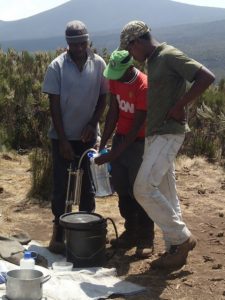 Our guides will remind you to drink, drink, and drink more water to aid in acclimatization and keep you well hydrated. We suggest you bring several packages of sports drink powder, which will add flavor to your water (to encourage you to drink more) and for important electrolyte replacement.
Our guides will remind you to drink, drink, and drink more water to aid in acclimatization and keep you well hydrated. We suggest you bring several packages of sports drink powder, which will add flavor to your water (to encourage you to drink more) and for important electrolyte replacement.
SENE provides clean drinking water on the climb with a Swiss made purification pump, Katadyn® Expedition KFT purification filter.
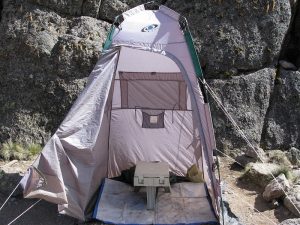 On every climb we set up at camp portable toilets with an eco-friendly biodegradable Cleanwaste® disposal system. Each toilet has its own privacy tent complete with toilet paper. Number of toilet tents depends on group size and gender distribution.
On every climb we set up at camp portable toilets with an eco-friendly biodegradable Cleanwaste® disposal system. Each toilet has its own privacy tent complete with toilet paper. Number of toilet tents depends on group size and gender distribution.
During the hiking day climbers relieve themselves off the trail and away from water sources. The lead guide carries a trowel in case waste needs to be buried.
Oxygen Saturation
Contrary to popular belief, air is not sucked into the lungs but rather it is pushed in by atmospheric pressure. As altitude increases, pressure decreases and therefore less oxygen is pushed into the lungs. Hemoglobin is a protein that is carried by red blood cells. It picks up oxygen in the lungs and delivers it to cells throughout the body. At sea level, typically 96 to 98 percent of hemoglobin molecules in the blood are saturated with oxygen. As altitude increases, less oxygen gets to the blood so it becomes less fully saturated.
As the oxygen saturation percentage falls to the low 90s, most of us would be aware of “feeling different,” as the first symptoms of hypoxia (oxygen deficiency) appear. These sensations vary from person to person but may include lightheadedness, increased heart and respiratory rate, lip tingling, deterioration of night vision, and mild memory impairment. Other physiological changes that naturally occur at altitude include increased heart rate, respiratory rate, metabolic rate, and (sometimes) blood pressure.
You may notice this in the afternoon and evening after arriving at a (higher elevation) camp. Overnight your body adjusts and your oxygen saturation rises and the sensations dissipate – though the saturation rate will not return to your rate at sea level. At higher elevations blood may have as little as 70 percent or less saturation rate. Thus, the oxygen saturation rate that provides a good indicator of ones adaptation to high altitude and susceptibility to Acute Mountain Sickness (AMS), commonly known as altitude sickness.
Acute Mountain Sickness
The symptoms of AMS may include headaches, fatigue, shortness of breath, a feeling of euphoria, or nausea. Four key factors usually determine whether a person will experience symptoms of AMS: (1) speed of ascent; (2) altitude reached; (3) health status (factors such as nutrition, dehydration, fatigue, and illness will increase risk); and (4) individual characteristics (genetic influences or some unusual metabolic or circulatory variant may affect susceptibility).
Although less common, High Altitude Pulmonary Edema (HAPE) and High Altitude Cerebral Edema (HACE) are more serious than AMS. At higher altitude, fluid develops in the lung tissue that separates air sacs, alveoli, from capillaries. Typically this is promptly reabsorbed. If it is not and accumulates in the alveoli, movement of oxygen from the lungs to the blood is impaired and more fluid accumulates in the air sacs. Symptoms of HAPE include shortness of breath even at rest and an irritative cough that may produce a frothy, often blood-tinged sputum. Mental confusion, extreme fatigue, and a struggling drunken walk may soon follow; the climber will slip into coma unless treated promptly. HACE, although extremely rare, can be fatal with little to no warning. It is believed to be due to parts of the brain being waterlogged. One early sign of HACE is difficulty in walking (also seen in HAPE) and with finger and hand motions.
Some climbers choose to take acetazolamide (Diamox), which is known to be effective at reducing the symptoms of altitude sickness. It is available only by prescription, the use of which is the choice of individual climbers in consultation with a medical professional. Simon himself regularly uses homeopathic remedies for his health and when on the mountain. He recommends the following Homeopathic Climbing Kit for Kilimanjaro.
- Eat regular nutritious meals
- Drink lots of fluids
- Gain altitude slowly (acclimatize)
- Sleep at least 8 hours
- Inform your guide of any signs or symptoms you experience – even if only minor
- Keep a smile on your face
Preparation
Kilimanjaro is a challenging mountain and training prior to a climb is necessary. If not doing so already, we recommend that you start a training program several months before departure, then slowly build up to a more strenuous level. An effective conditioning program must contain aerobic activity that increase the heart rate for a minimum of 45-60 minutes four times per week. Strengthen leg muscles used for trekking by running, skiing, bicycling, rollerblading, hiking, stair-climbing or working on equivalent machines in a gym. Since training is sport-specific, always include some hiking, running, or strenuous walking into your program. Do these wearing a backpack of 10-15 lbs / 5-7 kgs, which will be the approximate weight of the day pack you will carry on Kilimanjaro. If you intend to use hiking poles, make sure you practice using them on both ascents and descents. Please consult your physician if your body is not responding well to exercise or if you have questions concerning your underlying health.
Being “in shape” does not necessarily guarantee good performance at altitude – but it helps since your body has adapted to working efficiently under physical duress. Everyone, even athletes who train compulsively, will experience a steady decrease in maximum exercise capacity with increasing altitude (3%/1,000′), as your physiological efficiency decreases as you climb higher. In any case, being “out of shape” definitely increases your chances of faring poorly on Kilimanjaro!
If you are enthusiastic, open-minded, and physically fit for hiking you will be well-prepared for your Kilimanjaro climb!
Each climber’s duffel bag, sleeping bag, and sleeping pad are placed into one extra large water-repellent canvas duffel bag provided by SENE and carried by the mountain crew.
The Climb Group
Regardless of the size of the group, we provide our complete climb services and equipment for safety and comfort.
To confirm a climb we require a minimum of 2 climbers. We can confirm a climb with 1 climber if the person agrees to pay a solo supplement should no other climbers join the group (we can never guarantee that others will book a particular climb). See information below on solo climber versus single climber.
Single climbers who book a climb on which there are no other confirmed climbers (or who request a private 1-person climb) must pay a solo supplement (which is higher than a single supplement; rates vary by route). If others join the climb then the solo supplement is waived. However, we can never guarantee that other climbers will join any particular climb group.
Route Information
Those spending a night in the crater will have a day time ascent to the crater rim and down into the crater on the day prior to the crater overnight. The next morning climbers begin their summit ascent at daybreak or slightly before as it is a modest 45-minute hike to the summit from the crater floor.
Some climbers not overnighting in the crater may prefer a day time summit. We can accommodate this by making route adjustments that include a much longer descent on the final day. Please note that a day time ascent means the summit is likely to be shrouded in clouds upon arrival (early afternoon) and with a greater likelihood of inclement weather. A day time summit must be requested at the time of booking your climb and must be observed by all climbers in the group (we cannot split up a climb group into separate night time and day time summiters).
In 2006 there was a rock slide on the Breach that killed 3 climbers. The route was closed until early 2008, at which time the Kilimanjaro National Park Authority re-opened it with strict procedural requirements to ensure all climbers’ safety (early morning ascents before the afternoon ice melt loosens rocks; a route that avoids areas of greatest danger; use of helmets by all clients). At that time SENE again used the Western Breach ascent on Lemosho Crater climbs, strictly adhering to all KINAPA regulations.
In September 2015 there was another rock slide killing 1 climber. Based on the timing and nature of this recent slide, it appears to have been a geologic event not attributable to the ice melt that is the more common cause for slides on the Breach. Since then SENE has stopped guiding climbs via the Breach because of the extreme danger it poses to our climbers and crew due to the unpredictable timing and location of the slides. All our Lemosho Crater routes now ascend via Barafu to Stella Point and into the crater.